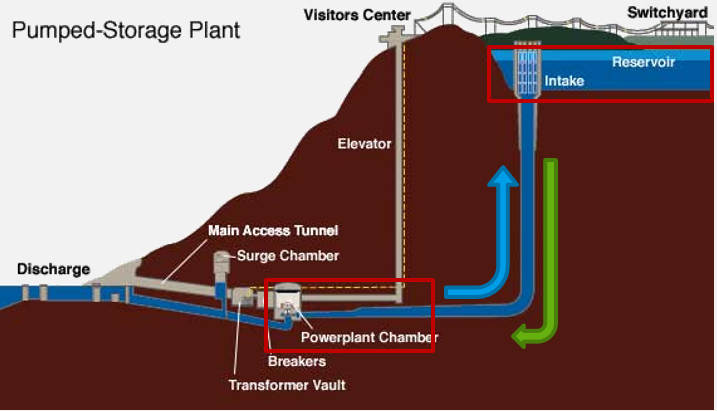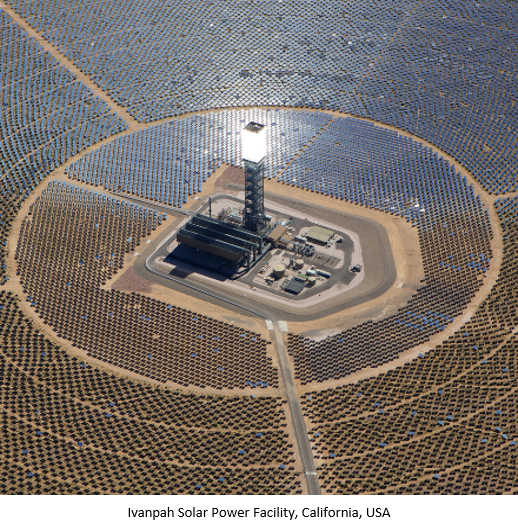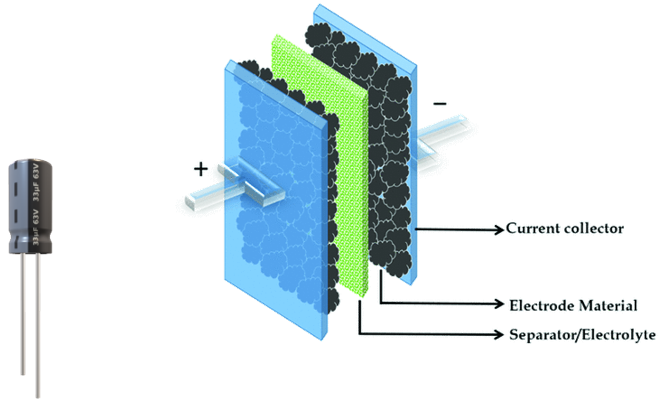2.2.2 Lecture Notes Technologies for Energy Storage
Course subject(s)
2. Flexibility Through Energy Storage & Demand Side Management
This image is from freepik
This lecture will discuss different technologies for energy storage that are typically used in the integrated energy systems. The main focus will be on technologies with direct integration in the electricity grids. The following topics will be discussed:
- Pumped-hydro storage
- Batteries
- Compressed air
- Solar-thermal
- Flywheels
- Supercapacitors
- The comparison between the different technologies
Pumped-hydro storage
The first technology that will be discussed is pumped-hydro storage, which has been around as one of the longest. Pumped-hydro storage is essentially a reservoir of water located upstream of the hydro power plant. This water in the reservoir can be passed down to the turbine, which can then generate electricity, to generate electricity. To store energy, an electric pump can be installed next to the turbine to push the downstream water back into the reservoir.
This is a form of potential energy storage, where the energy is stored in the height differences between the reservoir and the downstream river. Since large amounts of water can be stored at relatively high heights, large amounts of energy can be stored in the order of tens of gigawatts. The efficiency of this method is around 80%.

Batteries
Batteries use electrochemical reactions to store energy. The three most common types of batteries are:
- Li-ion
- Redox flow
- Lead-acid
Li-ion and lead-acid store energy in solid electrodes, and redox flow batteries store the energy in liquid electrolyte. In both cases, the chemical nature of the elements in the battery is changed. The different batteries can be ordered in terms of the energy density. Li-ion has the highest energy density, followed by lead-acid, and redox flow batteries have the lowest energy density.
The capacity of li-ion batteries is determined by the number of li-ions that can be moved between electrodes, and its rate of charge depends on the current density that can be maintained at the electrodes.
Redox flow batteries are different from the other batteries, since the energy storage can be decoupled from the electrodes. The power is determined by the electrode reactions and the capacity is determined by the amount Supof liquid. This makes it easier to store large amounts of energy. However, since the energy density is low, it requires a large storage footprint.
Compressed air
Another storage technique is compressed air. This is a kind of storage, which is built in connection to the electricity generation process. The excess energy is used to compress air to a higher pressure, such that the pressure can be released when energy is needed. The compressed air has been used in natural gas power plants, where it can significantly increase the efficiency.
Typically, underground salt caverns are used to store the air. Due to temperature effects on compression and expansion, the calculation becomes more complex.

Solar-thermal
Energy can also be stored as heat. This is used in solar-thermal power plants. The energy of the sun is reflected to a collector by using mirrors. This collector contains a medium, molten salt, which has good thermal properties and can keep the heat overnight. The heat that is stored in the medium can be used to produce steam to run a generator to produce electricity. The challenge of this technology is that it as a small energy density and it requires large volumes.

Flywheels
In flywheels, kinetic energy is stored in the rotation. Flywheels are mechanical devices placed in a vacuum, such that friction losses are minimized. They can be used in applications, where it might be dangerous to use electrochemical storage, for example on aircraft or spaceships. The efficiency rate of flywheels is around 85%.

Supercapacitors
Supercapacitors are essentially large capacitors that store energy in an electric field. Electrons can be collected at one electrode (when energy is stored) or can be released (when the capacitor is discharged). An advantage of a capacitor is that it can generate a huge amount of power, however only for a short amount of time. Another disadvantage is that the amount of energy storage is limited.

The comparison between different technologies
In the figure below, a comparison between the different technologies is made in terms of the energy capacities and rate of charge. Some technologies are more suitable for short time scales (the bottom left corner), while other technologies are suitable for long time scale (the top right corner). In a renewable-rich energy system, a mix of the technologies need to be used.
The conversion of electricity into gas and fuel is listed in the top right corner. This conversion was technically feasible in the past, it only became needed with the increase of renewable energy. Such conversions are considered as emerging storage options, since it will be used at scale in the future.
Conclusion
This lecture discussed different types of storage technologies and the main characteristics of these technologies. Finally, a comparison was made between the different technologies.

Technology of Intelligent and Integrated Energy Systems by TU Delft OpenCourseWare is licensed under a Creative Commons Attribution-NonCommercial-ShareAlike 4.0 International License.
Based on a work at https://online-learning.tudelft.nl/courses/technology-of-intelligent-and-integrated-energy-systems/



